Click below to jump to an article of interest.
Qualifying Drilling Sensor Systems
SwRI is helping lead the first phase of a joint industry program (JIP) to verify and validate oil and gas drilling sensor systems. The Independent Verification and Validation (IV&V) of Sensors and Systems in Drilling JIP will develop techniques to classify sensor abilities affecting drilling data and impacting operations, analytics and automation.
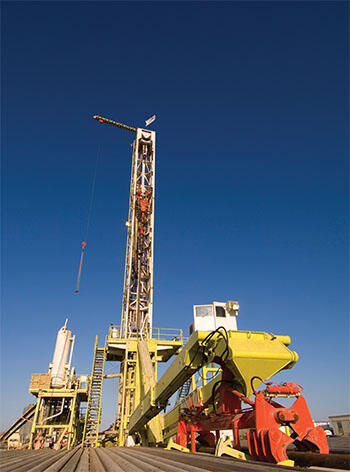
“SwRI has significant experience in areas relevant to the development of recommended practices for sensors and systems IV&V used in drilling,” said Maria Araujo, a manager in SwRI’s Intelligent Systems Division who is co-chairing the program. “SwRI has decades of IV&V expertise in analysis, control and automation sensors used in many high-technology industries, including oil and gas. SwRI will work with drilling industry experts to identify and rank critical sensor systems.”
Some critical drilling equipment and sensors have proven insufficient for specific tasks, particularly as the industry employs more data analytics and automation. Technology is often inadequately calibrated or maintained or is used in applications outside its operational parameters. In addition, data transfer channels and time stamping are susceptible to reliability problems. In Phase 1, the program will classify sensors and systems used throughout the drilling operation to prioritize IV&V standard setting and identify a critical system for a pilot study.
“Formal industry-accepted verification and validation of sensors, equipment and systems will benefit both suppliers and customers,” Araujo said. “Suppliers can verify their products, and customers will have access to validated attributes and capabilities. Suppliers can accelerate market readiness using a standardized test rather than conducting minimal or arbitrary tests for each new installation. Similarly, customers will have faster access to certified sensors and systems. And importantly, poor sensors and systems will not pass evaluations, avoiding safety risks and costly consequences associated with using inferior systems.”
The Society of Petroleum Engineers (SPE) Drilling Systems Automation Technical Section (DSATS) is administering the program. Drilling industry expert John de Wardt will co-chair the JIP with Araujo. JIP membership is open to petroleum companies, drilling contractors, service companies and equipment suppliers. International participants are welcome.
The Institute is uniquely positioned to support this initiative, with more than 25 years participating in collaborative programs. The approach allows clients to pool their R&D dollars for precompetitive research, offering a more cost-effective approach to solving problems. JIP participants have full rights to the intellectual property developed during the course of their membership, and the results are planned for release as a Drilling Industry Recommended Practice.
Cancer Challenge Champs
SwRI joined forces with UT Health San Antonio pathologists to place first in an international challenge to develop automated methods to detect breast cancer tumor cells. They trained a computer algorithm previously used for automotive, robotics and defense applications to identify cancer cells for the BreastPathQ: Cancer Cellularity Challenge.
“Adapting an autonomous robotics algorithm to solve a health diagnostics problem shows that we really have state-of-the-art techniques,” said Hakima Ibaroudene, the SwRI engineer who led the winning effort. “Our method has the potential to improve medical imaging diagnostics, ultimately bolstering healthcare for cancer patients.”
Developing the cancer-detecting algorithm began with UT Health San Antonio pathologists teaching SwRI engineers to recognize breast cancer tumor cells. The engineers then trained the computer algorithm to analyze cell images, looking for defining characteristics that distinguish cancerous cells from normal ones. Once trained, the SwRI algorithm scanned images provided for the challenge, matching the findings of human pathologists at the highest rate, making it the top-performing algorithm out of 100 competing submissions.
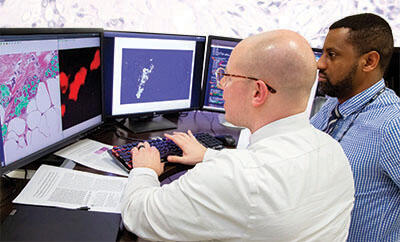
SwRI engineers David Chambers and Donald Poole trained a detection algorithm, using breast cancer tumor cell images, to win the BreastPathQ: Cancer Cellularity Challenge. Out of 100 submissions, their algorithm placed first in the international challenge to develop an automated method to detect breast cancer tumor cells.
“The results demonstrated the importance of understanding network design and training the algorithm versus using an ‘out-of-the-box’ model,” said David Chambers, SwRI engineer. “Our approach was driven by subject matter expertise.”
Challenge organizers provided two collections of images: one to train the algorithms, the other to test them. The team analyzed images extracted from breast cancer patients and assigned a score based on the number of cancer cells in each image. Pathologists track tumor response to therapy by determining the percentage of tumorous cells in the area. Currently, this task is performed manually and relies on experts to interpret complex tissue structures. A reliable automated method could produce more consistent results and avoid potential human error.
“Artificial intelligence and machine learning approaches to medical image analysis will provide pathologists with a powerful tool to more rapidly identify and quantify important image features,” said Dr. Bradley Brimhall, UT Health San Antonio pathologist and challenge participant. “In doing so, additional diagnostic and prognostic information will be available for providers to guide cancer treatment.”
The challenge team also included Donald Poole, SwRI engineer, and Dr. Edward Medina, UT Health San Antonio pathologist. The American Association of Physicists in Medicine, the National Cancer Institute and SPIE, the international society for optics and photonics, sponsored the challenge. The team presented their winning algorithm at the 2019 SPIE Medical Imaging Conference in San Diego.
SwRI Tool Targets Oil Spills
SwRI engineers have created an interactive decision tree designed to find the best mitigation methods for specific oil spill scenarios. Numerous chemical dispersant technologies are available, and countless variables and conditions affect the performance of any given dispersant. SwRI’s decision-making tool helps users understand how a dispersant technology will perform under different spill scenarios.
Led by SwRI Research Engineer Dr. Amy McCleney, the team designed the decision tree for the U.S. Department of Interior’s Bureau of Safety and Environmental Enforcement to train individuals who respond to oil spill incidents.
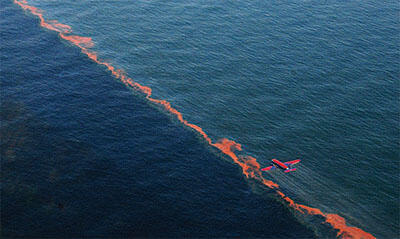
Courtesy of Stephen Lehmann, U.S. Coast Guard
An airplane sprays chemical dispersants on an oil slick in the Gulf of Mexico during the 2010 Deepwater Horizon oil spill.
“When an oil spill occurs, chemical dispersants, distributed by boat or airplane, enhance the breakup of spilled oil on water into small droplets, which dissipate in the surrounding ocean,” McCleney said. “Microorganisms then degrade the small oil droplets to remove the harmful pollutants from the water.”
Choosing the best technology for oil spill cleanup is extremely challenging due to numerous spill scenario combinations that can affect the overall response outcome. The SwRI tool supports hundreds of scenario combinations. Users select certain environmental and oil conditions, and the tool determines the most efficient dispersant and delivery approach to clean up the spill. For example, the thickness of an oil slick is a major variable affecting how much dispersant is needed to break up the spill.
“This is a game changer for oil spill preparedness, because oil spill cleanup thus far has been a relatively subjective process,” she said. “This tool can help transition spill response operations into a more objective, systematic and measurable approach.”
McCleney and fellow SwRI engineers Maria Cortes, Jacqueline Manders and Kevin Supak based the tool on an existing equipment efficiency system developed at SwRI. The team spent a year researching literature and interviewing industry experts, identifying the most efficient oil spill cleanup practices from across the industry to incorporate into the singular decision tree.
“In the end, this is all about protecting our coastlines and the public from oil,” McCleney said. “This tool can train responders to select the best oil cleanup method before an event such as the Deepwater Horizon oil spill occurs, to implement more effective and timely responses.”
Energy Storage Solutions
SwRI has received a \$2 million grant from the United States Department of Energy’s Advanced Research Projects Agency–Energy to develop an advanced pumped heat electricity storage system. This system offers twice the energy density of a lithium ion battery using an innovative thermodynamic cycle to store energy in hot and cold fluids.

“It’s important, now more than ever, to invest in innovative solutions that can help deliver on the promise of effective, renewable energy,” said Danny Deffenbaugh, vice president of SwRI’s Mechanical Engineering Division. “This new energy storage system is a wonderful example of research that benefits the world we live in, which SwRI engineers are committed to pursuing.”
To implement renewables such as solar or wind energy on a larger scale, new energy storage technology is critical to match intermittent supplies with customer demand. The SwRI team, led by research engineer Brittany Tom, plans to build the new kW-scale energy storage demonstration system over the next two years.
“Grid-scale energy storage technologies like this one address a critical need for renewables on electricity grids worldwide,” Tom said.
In this new system, electric energy from the grid is converted into thermal energy and stored as a thermal potential. At full capacity, the system could store energy for hours or up to several weeks before converting it back to electrical energy. The capacity of the system can be easily extended by increasing the volume of the storage tanks. The technology offers a low-cost solution when compared to “peaker” plants, which generate and provide electricity during the peak demand hours of the morning, later afternoon and evening.
Visit Energy Storage Systems or Machinery for more information.
Using Space Thermodynamics to Predict Space Weather
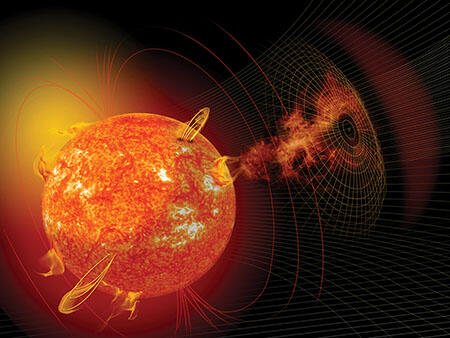
Courtesy of NASA
Research conducted by SwRI’s Dr. George Livadiotis has shed new light on predicting the thermodynamics of the solar wind and “space weather” events. Solar flares and coronal mass ejections release hot, fast-moving plasmas that transmit magnetic fields from the solar corona, as depicted in this illustration. He calculated the distribution of particle velocities at thermal equilibrium when streams of particles are moving en masse, behavior typical of space and astrophysical plasmas. By measuring the macroscopic properties of plasmas, we can now understand and predict the microphysics of these plasmas. The new results are published in Astrophysical Journal.
iopscience.iop.org/article/10.3847/1538-4357/ab05b7/pdf
Space Optimized Optocoupler
SwRI has developed a high-reliability, high-voltage optocoupler for spaceflight applications. NASA has selected the device as a power interface between the Europa Clipper spacecraft and three onboard instruments bound for Jupiter’s moon Europa in the next five years. The power converter, developed with internal funding, overcomes reliability problems similar systems have had operating in space.
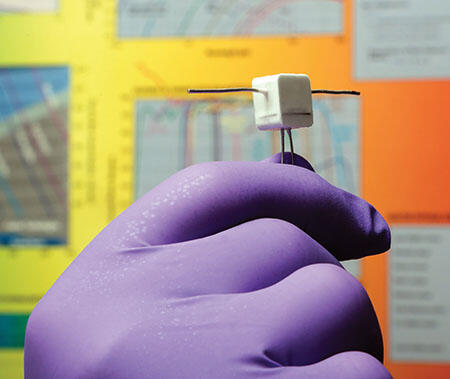
SwRI is integrating its optocoupler power conversion technology into three instruments bound for Jupiter’s moon Europa. The radiation-hardened, high-reliability device overcomes problems similar systems have had operating in space.
An optocoupler, also known as an opto-isolator, transfers electrical signals between two isolated circuits using light, in this case an array of LED sources. The SwRI device enables 15 kilovolts of isolated, low-voltage control for space instruments operating at up to 10.5 kV.
“Operating in conditions from -40 to 100 degrees Celsius, our power converter is ruggedized to withstand the rigors of launch and adverse radiation conditions in space,” said SwRI’s Carlos Urdiales. “In addition to withstanding the radiation environment around Jupiter, our optocoupler is fast, stepping from 0 to 10 kilovolts in 23.4 microseconds. The half-inch package weighs less than 4 grams and has a radiation tolerance in excess of 100 kilorads.”
The high-quality device offers high reliability and long life in a relatively small footprint, which is critical for space applications. The optocoupler is being integrated into the MAss SPectrometer for Planetary EXploration (MASPEX), the Plasma Instrument for Magnetic Sounding (PIMS) and the SUrface Dust Analyser (SUDA) instruments for the Europa Clipper mission. SwRI’s optocoupler will help power astrobiology examinations to understand the moon’s subsurface sea and potential habitability as well as characterization of its atmosphere, ionosphere and magnetosphere.
“SwRI’s SW1001502 octocoupler is a highly reliable choice for high-voltage electrostatic analyzers, deflectors, bias and custom stepping power systems,” said Senior Engineering Technologist Dennis Guerrero. “It can also be used as a high-voltage linear control element, a current source or an operational amplifier output stage.”
Visit Power Systems for more information.
Sampling Mercury's Exosphere
On October 20, the European Space Agency’s BepiColombo spacecraft launched for Mercury carrying a unique payload designed and built at SwRI: an instrument called Strofio, designed to study Mercury’s tenuous exosphere. Part of the SERENA suite of instruments, Strofio’s measurements will help us better understand the planet’s surface and the history of the smallest rocky planet orbiting close to the Sun.
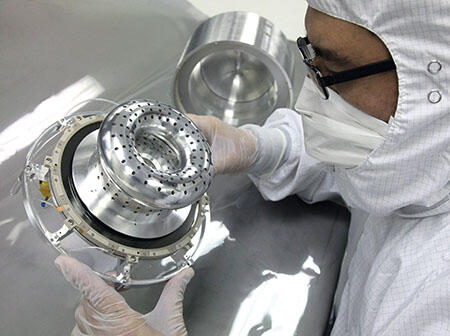
SwRI designed Strofio, a basketball-sized instrument weighing just over 7 pounds, to measure particles in Mercury’s sparse exosphere.
“An exosphere is different from an atmosphere,” said Dr. Stefano Livi, the Institute scientist who leads the Strofio experiment, funded by NASA’s Discovery Mission of Opportunity program. “Mercury doesn’t have enough gravity to hold onto a permanent atmosphere. Instead, it is surrounded by a thin, collision-free particle environment. Several mechanisms act on the surface of Mercury that can free particles from the soil. As atoms leave the surface they briefly populate this exosphere before they return to the surface or drift away into interplanetary space.”
Mercury’s proximity to the Sun makes it difficult to observe from Earth. It is also challenging for spacecraft to reach the planet and to survive in its harsh environment. The BepiColombo mission includes two spacecraft — ESA’s Mercury Planetary Orbiter (MPO) and the Japan Aerospace Exploration Agency’s Mercury Magnetospheric Orbiter. From aboard MPO, Strofio will study how Mercury’s exosphere and magnetosphere interact with each other and with the planet’s surface.
“Strofio is novel in its ability to detect the rare, static particle population in Mercury’s exosphere,” Livi said. “We had to rethink and retool typical spectrometer designs.”
To understand these interactions, Strofio must identify the particles escaping from Mercury’s surface. Because the exosphere is so thin, sampling particles is particularly challenging — in fact, the particle density is so low that the instrument had to be commissioned in specialized facilities at the University of Bern. Every particle captured is analyzed in a rotating field. When and where each particle gets to the detector determines the mass of each particle. Strofio uses detection algorithm tools to enhance the instrument’s sensitivity and improve identification.
Green Skies
Since 2008, SwRI has supported environment management activities for the U.S. Air Force and other federal agencies to improve energy efficiency and reduce greenhouse gas emissions. Our engineers are helping the Department of Defense develop gas leak detection, capture and reuse technologies.
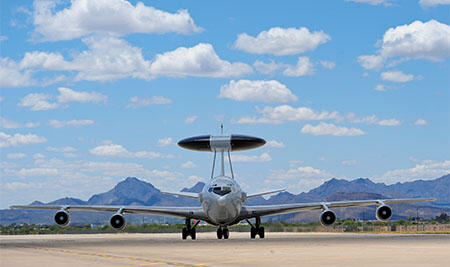
Courtesy of USAF/Airman 1st Class Chris Massey
One target is sulfur hexafluoride (SF6), a colorless, odorless, nonflammable gas used as an electrical insulator in the E-3 aircraft’s communications equipment. The E-3 airborne warning and control system (AWACS) conducts surveillance, command, control and communications functions for tactical and air defense around the world. According to the U.S. Environmental Protection Agency, SF6 is a potent greenhouse gas. Its global warming potential is 23,000 times that of CO2 over 100 years, and it remains in the atmosphere for up to 3,200 years.
SwRI has studied the feasibility of reclaiming, recycling, replacing and potentially reducing the use of gaseous SF6 in the AWACS platform. Engineers conducted an extensive search for replacement candidates that provide equal or better performance and meet safety guidelines for health, flammability and instability hazards in a flight application.
Using a custom-designed test cell, SwRI evaluated the high-voltage negative DC electrical breakdown of potential gas candidates over the range of pressures and conditions experienced by AWACS equipment. Working with Texas Tech University’s Center for Pulsed Power and Power Electronics, engineers measured S-band RF power using several promising gas admixtures that potentially satisfy technical and safety requirements for the aircraft’s antenna and waveguide components. The Air Force is currently evaluating research results.
Volcanic Eruption Lights Up Io on Earth's Darkest Night
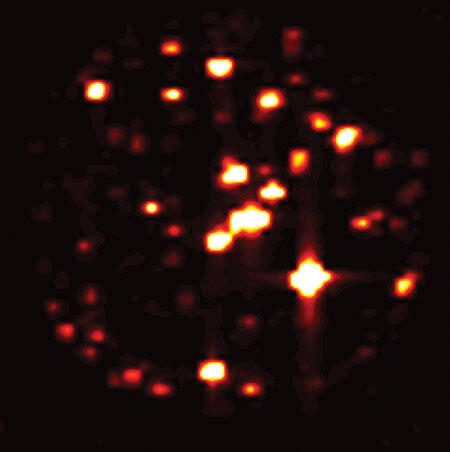
Courtesy of NASA/JPL-CALTECH/SwRI/INAF
A team of space scientists has captured new images of a volcanic plume on Jupiter’s moon Io during the Juno mission’s 17th flyby of the gas giant. On Dec. 21, during Earth’s winter solstice, four of Juno’s cameras captured images of the moon’s polar regions as well as evidence of an active eruption.
“We knew we were breaking new ground with a multi-spectral campaign to view Io’s polar region, but no one expected we would get so lucky as to see an active volcanic plume shooting material off the moon’s surface,” said Dr. Scott Bolton, principal investigator of the Juno mission and an associate vice president of SwRI’s Space Science and Engineering Division. “This was quite a New Year’s present showing us that Juno has the ability to clearly see plumes.”
JunoCam, the Stellar Reference Unit (SRU), the Jovian Infrared Auroral Mapper (JIRAM) and the Ultraviolet Imaging Spectrograph (UVS) observed Io for over an hour, providing unprecedented images of the most volcanic body in the solar system.
Asteroid Assault Accelerated in Past 300 Million Years
SwRI scientists recently looked to the Moon to better understand the impact history of the Earth. The research, published January 18 in the journal Science, discovered that the rate of sizable asteroid collisions has increased by a factor of two to three on both bodies over the past 290 million years.
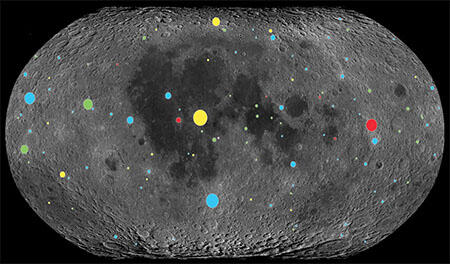
Courtesy NASA/LRO/USGS/University of Toronto
SwRI was part of a team that used Lunar Reconnaissance Orbiter data to study the Moon’s craters, scaled by size and color-coded by age here, to understand the impact history of the Earth. This illustration shows a lunar surface dominated by blue craters less than 290 million years old, which is consistent with those on Earth, indicating that bombardments on both bodies have increased since that time.
Earth has fewer older craters than expected compared to other bodies in the solar system, making it difficult to find an accurate impact rate and to determine if it has changed over time. Many experts assumed that the earliest Earth craters may have been worn away by wind, storms and geologic processes, mechanisms not present on the Moon.
Lunar craters experience little erosion over billions of years, but scientists could not pinpoint their ages until NASA’s Lunar Reconnaissance Orbiter (LRO) started circling the Moon a decade ago. Using images and thermal data collected by LRO, SwRI scientists and collaborators calculated the ages of large lunar craters across the Moon.
“What this research uncovered is that the Earth has fewer older craters on stable terrains, not because of erosion, but because the impact rate was lower prior to 290 million years ago,” said SwRI’s Dr. William Bottke. “The Moon is like a time capsule, helping us understand the Earth. We found that the Moon shared a similar bombardment history, which meant the answer to Earth’s impact rate was staring everyone right in the face.”
Putting Solar Activity in Perspective
An international team led by SwRI has developed a new technique for looking at historic solar data to distinguish trustworthy observations from those that should be used with care. This work is critical to understanding the Sun’s past and future as well as whether solar activity plays a role in climate change.
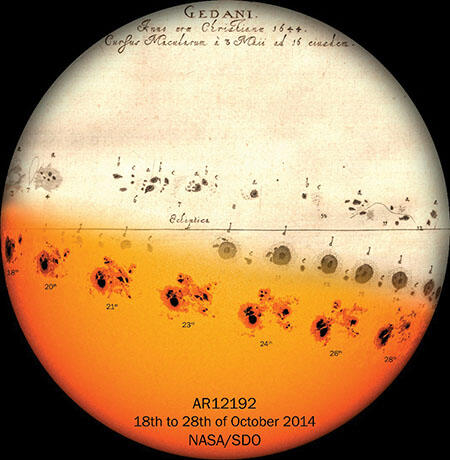
“Scientists have been monitoring solar activity since Galileo made the first drawings in 1612 by counting sunspots and groups of sunspots,” said SwRI’s Andrés Muñoz-Jaramillo, a senior research scientist who is lead author of a paper in Nature Astronomy outlining the research. “However, putting all observations in perspective is quite challenging due to wide-ranging observation techniques and telescope magnifications used. We see much more now and our understanding of what we see changes the way we count spots.”
The team, which included José Manuel Vaquero of the University of Extremadura (Spain), created a technique that takes all historic data gathered and digitized thus far and combines them visually, to provide a complete picture of the data we have and where are we missing information.
Roughly every 11 years, the magnetic structure and activity of the Sun cycle between periods known as solar minimum and solar maximum. During solar maximum, the Sun emits high levels of solar radiation, ejects large amounts of solar material and displays large numbers of intense sunspots, flares and other phenomena. During solar minimum, this activity is muted. Changes on the Sun cause effects in space, in the atmosphere and on Earth’s surface. The Sun also experiences longer variations.
“One has to be very careful when using historic sunspot data to study potential links between the Sun and changes in terrestrial climate, given that these effects would be complex and subtle,” Muñoz-Jaramillo said. “Our work uses historical data to provide context to users of these estimates who may not be aware of their limitations.”
Next-Gen MST Technology
A new, more powerful generation of SwRI’s patented MagnetoStrictive Sensor can withstand extreme temperatures, automatically adjusts frequencies and incorporates a stronger magnet. The compact magnetostrictive transducer (MsT™) more accurately detects potential problems in oil, gas and chemical industry structures such as pipelines, storage tanks and anchor rods.
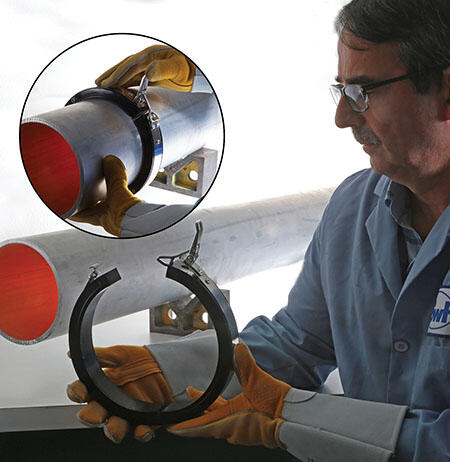
“The MsT system offers the next level of signal strength. This user-friendly technology more precisely locates structural issues,” said Dr. Sergey Vinogradov, the SwRI staff engineer who led the upgrade initiative. “It is an extremely reliable, state-of-the-art, durable sensor that you can install just about anywhere.”
The circular, hard-shell MsT sensor clamps around pipes and other structures and is available in circumferences ranging from one-half inch to 70 inches. It detects material flaws, corrosion and areas at risk of developing cracks and leaks. At just 1.1 inches wide, MsT uses less shear-wave couplant, a gel that aids energy transmission, and requires less clamping force when dry coupled. The MsT sensor can be permanently installed on a structure to provide ongoing monitoring.
“The MsT is compact and easy to install, but it’s also more convenient,” Vinogradov said. “With this improved sensor, the operator does not change hardware to change frequencies. And this function is automated, which reduces human error. This feature is especially useful when the sensors need to be installed at multiple, hard-to-access locations.”
High temperatures accelerate corrosion in metal structures. For that reason, MsT is designed to withstand up to 500 degrees Celsius. It can be installed on extremely hot structures to detect weaknesses and can also withstand temperatures significantly below freezing.
Seeing Through Titan's Enigmatic Atmosphere
SwRI scientists recently tackled one of the greatest mysteries about Titan, one of Saturn’s moons: the origin of its thick, nitrogen-rich atmosphere. A new study published online in The Astrophysical Journal posits that Titan’s murky atmosphere comes, at least in part, from organic material “cooked” in the moon’s interior.
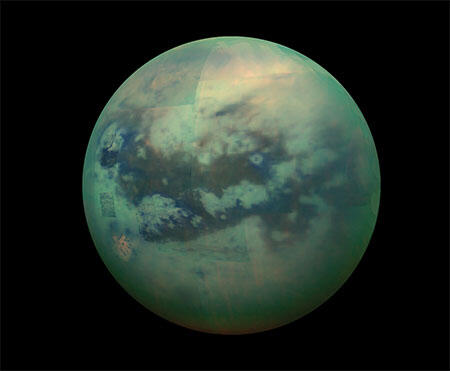
Courtesy of NASA
“Titan has this very thick atmosphere, which makes it unique among moons in our solar system,” said Dr. Kelly Miller, lead author of the study. “It is also the only body in the solar system, other than Earth, that has large quantities of liquid on its surface. Titan, however, has liquid hydrocarbons instead of water. A lot of organic chemistry is no doubt happening on Titan, so it’s an undeniable source of curiosity.”
The atmosphere of Saturn’s largest moon is extremely dense, even thicker than Earth’s atmosphere, and mostly nitrogen. It’s also about 5 percent methane, which reacts quickly (by astrophysical standards) to form organics that gradually fall to its surface. This means atmospheric methane would either need to be replenished or that current conditions are transient and unique.
“The leading hypothesis has been that ammonia ice from comets was converted, by impacts or photochemistry, into nitrogen to form Titan’s atmosphere,” Miller said. “While that may still be an important process, it does not account for what we now know is a very substantial portion of comets: complex organic material.”
To study the Titan mystery, Miller combined existing data from organic material found in meteorites, which is similar to but less abundant than cometary organics, with previous thermal models of the moon’s interior. Miller found that “cooking” organics from Titan’s formation in its interior could produce about half the nitrogen, and potentially all the methane, in the moon’s enigmatic atmosphere.
Reconnection in the Earth's Magnetotail

Courtesy of NASA/GSFC
The latest findings of the SwRI-led Magnetospheric Multiscale mission detailed the magnetic reconnection processes taking place in the Earth’s magnetotail. Scientists discovered that the tail regions where magnetic fields meet, break apart and reconnect are surprisingly nonturbulent, but create hypersonic jets of electrons.
CYGNSS Extended
NASA has extended the Cyclone Global Navigation Satellite System (CYGNSS) mission for an additional year and a half. The constellation of microsatellites designed and built at Southwest Research Institute has made history over the last two years, penetrating thick clouds and heavy rains to accurately assess wind speeds and better understand hurricane intensification. Assessments confirmed that all eight spacecraft and their subsystems are healthy and ready to support two more years of operations.
The microsatellites — each roughly the size of carry-on luggage — make frequent measurements of ocean surface winds to monitor the location, intensity, size and development of tropical cyclones. Flying in formation, the spacecraft cover an orbital swath that passes over most of the Earth’s hurricane-producing zone, up to 35 degrees north and south of the Equator.

“Launched in late 2016, the spacecraft have provided round-the-clock surface wind speed measurements to help improve intensity forecasting of tropical cyclones,” said SwRI’s William Wells, CYGNSS operations phase systems engineer. “The extended mission opens the door for many new science opportunities, in addition to continuing the primary mission objectives. We are making some engineering and operational changes to enable new types of science while maximizing science returns in this second phase.”
This science is critical because, over the last few decades, forecasters have improved hurricane path prediction significantly, but the ability to predict the intensity of storms has lagged behind. Collecting data in the midst of a storm is difficult and dangerous, but conventional space technology could not provide accurate measurements. GPS signals penetrate intense rainstorms, and CYGNSS uses these signals, reflected off the ocean surface, to calculate wind speeds.
“For the extended mission, we are ramping up for four new investigations related to tropical cyclones, six in other oceanography disciplines, six that use CYGNSS data in groundbreaking land science applications and many others,” said SwRI’s Jillian Redfern, CYGNSS project manager and mission operations manager. “We are adjusting payload operations to support the new science applications while maintaining production of the core data products already in use by the science community.”
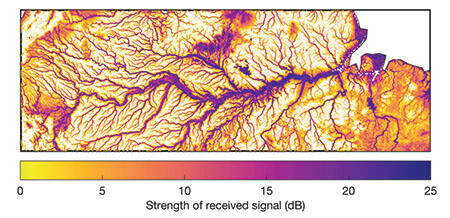
Courtesy of NASA/University Corporation for Atmospheric Research/University of Michigan
In the second phase, the CYGNSS mission has expanded to include land-based studies. In the prime mission, a surprising capability emerged — CYGNSS can characterize flooded landscapes and measure subsurface soil moisture, as seen in this CYGNSS map of the Amazon basin.
During the prime mission phase, CYGNSS science has led to 72 refereed journal publications and 158 conference proceedings publications in atmospheric, ocean and terrestrial science as well as space systems engineering.
“We have made extensive observations of inner core winds and demonstrated that assimilating these data into numerical weather prediction models has a significant positive impact on their ability to forecast a storm’s track, intensity and structure,” said Dr. Chris Ruf, CYGNSS principal investigator from The University of Michigan in Ann Arbor, Michigan. “In addition, bonus observations over land have uncovered a wealth of new science applications related to imaging of flood inundation and measuring subsurface soil moisture. I look forward personally to many more years supporting these efforts and helping to expand the community of our data users.”
SwRI led the engineering development and manages the operation of the constellation. The University of Michigan Climate and Space Sciences and Engineering Department leads the science investigation, and the Earth Science Division of NASA’s Science Mission Directorate oversees the mission. SwRI’s office in Boulder, Colorado, hosts the mission operations center, which commands the spacecraft, collects the telemetry and transmits the data to the science operations center at the University of Michigan.

